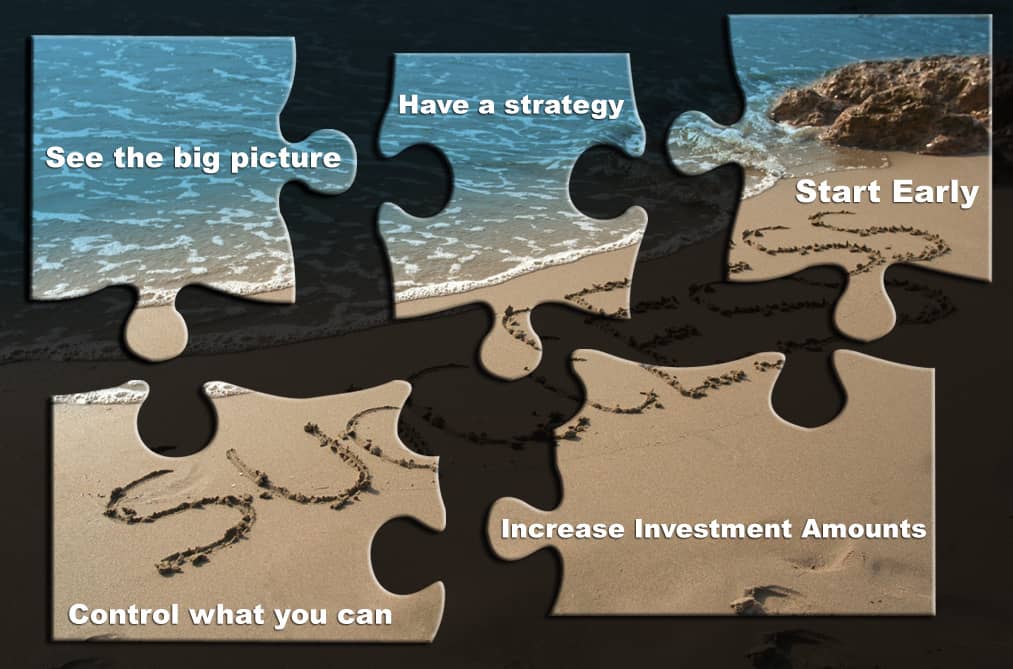While retirement may seem a long way off when you’re young and just starting to build a business – or older and rebooting – it’s important to have a retirement savings plan and stick to it to create the future you want.
Retirement planning can be difficult for anyone, but entrepreneurs and small business owners can face unique challenges. According to a 2013 American Express survey, 60 percent of small business owners said they weren’t saving enough for retirement, and over 73 percent said they were worried about not being able to afford the lifestyle they want in retirement.
While many employees can choose to make automatic deductions from their paycheck towards a 401k, for instance, entrepreneurs have to make a conscious decision to sock away money for retirement, as well as find plans that work for them.
Fortunately there are several things that you can begin doing now to contributing to your long-term financial future. As always, please review these and other options with your financial planner to see what strategy may be most suitable for your individual situation.
1) Open an IRA
If you haven’t already, now may be as good a time as any to open an Individual Retirement Account (IRA). IRAs are long term investments that allow you to save money for the future in a tax efficient way. They also offer catch up contributions if you’re over 50.
Traditional vs. Roth
Traditional IRAs allow you to deduct contributions the year in which they are made, then pay taxes when you withdraw the money. A Roth IRA allows you to pay taxes on your contributions now, rather than upon withdrawal and earnings and distributions may not be taxable if held in the Roth IRA for up to 5 years.
For older investors who are approaching retirement, traditional IRAs probably make more sense, as their tax rate may likely be lower in retirement than it is currently. Younger investors, however, may want to consider a Roth IRA if they believe their tax rate could be higher in the future than when they make their contributions.
Contribution Limitations
Regardless of whether you elect to contribute to a Roth or Traditional IRA the IRS sets annual limits each year stating the maximum individuals can contribute to their IRA based on their annual earnings. For instance, in 2015 you are limited to a maximum of $5,500 annually (or $6,500 if you are 50 or over).
Finally, with either type of IRA, there are penalties and taxes for early withdrawals prior to 59 ½ years old!
Please consult your tax professional regarding your specific situation and the specific rules that apply to you.
2) Consider alternative forms of IRAs to increase your contribution limits
If you are your company’s only employee, or you only have a couple of other employees, you may want to look into setting up either an SEP-IRA or a SIMPLE-IRA.
SEP-IRA
SEP-IRAs allow you to contribute up to 25% of your salary, or $53,000 (as of 2015) whichever is smaller. This is significantly more than what non-SEP-IRAs allow for.
Setting up a SEP-IRA may be an easy choice if you and your spouse are your only employees, but there can be other costs associated if you have other people working for you.
SIMPLE-IRAs
SIMPLE-IRAs provide an alternative that is cheaper for companies with several employees.
With the SIMPLE-IRA, the employer creates an IRA for each employee. Employees have the option to contribute a certain percentage of their income to their IRA. Employers are then required to match that percentage up to a maximum of three percent of the person’s salary, or contribute two percent of each person’s salary into the IRA.
By creating a SIMPLE-IRA the owner is then able to contribute an additional $12,500 ($15,500 for those 50 and over) to his or her own IRA.
If you have only a few employees working for you and you expect to contribute either the full $12,500 or a large portion of it, there is a good chance that your tax savings may more than pay for the cost of contributing to your employee’s IRAs. Please consult your tax professional for more specific information about how this could affect you and your employees.
3) Setup Automatic Deductions
Unfortunately, we all have a tendency to procrastinate, and thinking about retirement is often not at the top of our priorities! It’s easy for entrepreneurs and small business owners in particular to become distracted and forget to contribute to your retirement account(s). Automatic deductions solve this problem.
By setting up your IRA and other retirement accounts to take money directly out of your bank account or paycheck each week (or month,) you can ensure that you contribute as much money as you feel you can, up to the full tax deductible amount, each year. You no longer have to worry about forgetting to, or putting off, contributing.
With any IRA, think carefully about how much you can realistically contribute. They are considered long term investments and you cannot access the money prior to a specific age without incurring taxes and significant penalties for making early withdrawals. Please make sure you are carefully considering your short and medium term goals. And remember: starting to save early is a good way to get on the road to achieving your goals.
4) Speak with as Experienced Financial Planner to Help You Create a Plan
Taking care of long-term financial goals can be a challenge but fortunately you don’t have to go it alone. Financial planning professionals can help you create an individualized plan focused on your specific goals. Whether they are:
- Saving for retirement
- Saving for your children’s education
- Buying a home
- Having a baby
Financial planners are here to help you plan for the future you envision for yourself and your family.
With over a decade’s worth of experience in financial services, Brad Sherman is committed to helping his clients pursue their financial goals. Contact Brad today to learn more about how you can better prepare for retirement.
Learn more about our Retirement Planning services.
Related Reading:
Finding Financial Independence
YOLO (You Only Live Once) so you Need a Retirement Goal
Your 401K Program: A Little Savings Now Goes a Long Way
How Much Money do you Need for Retirement These Days?
The Benefits of Saving Early for Retirement
Advantages of Participating in Your Workplace Retirement Plan
LFS-1208487-052815









